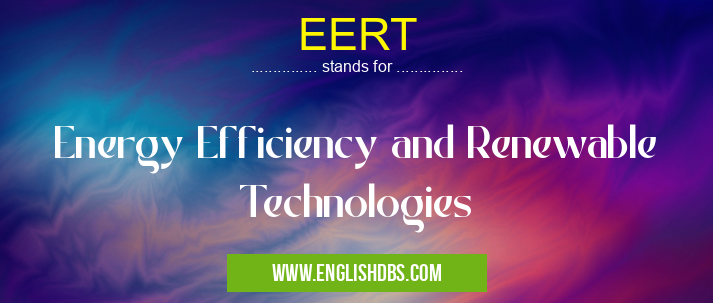What does EERT mean in ENERGY
EERT stands for Energy Efficiency and Renewable Technologies. It is a field that focuses on improving energy efficiency and promoting the use of renewable energy sources to reduce the environmental impact of energy production and consumption.

EERT meaning in Energy in Governmental
EERT mostly used in an acronym Energy in Category Governmental that means Energy Efficiency and Renewable Technologies
Shorthand: EERT,
Full Form: Energy Efficiency and Renewable Technologies
For more information of "Energy Efficiency and Renewable Technologies", see the section below.
» Governmental » Energy
EERT in GOVERNMENTAL
EERT plays a crucial role in governmental policies and regulations aimed at addressing climate change and transitioning to a sustainable energy system. Governments worldwide implement measures to encourage energy efficiency, such as building codes, appliance standards, and tax incentives. They also promote the development and deployment of renewable energy technologies through research and development funding, subsidies, and renewable portfolio standards.
Full Form of EERT
Energy Efficiency and Renewable Technologies
What does EERT Stand For?
EERT stands for the following:
- Energy Efficiency: Measures and technologies aimed at reducing energy consumption without compromising services or functionality.
- Renewable Technologies: Technologies that harness natural resources, such as solar, wind, and biomass, to generate electricity or heat without producing greenhouse gas emissions.
Essential Questions and Answers on Energy Efficiency and Renewable Technologies in "GOVERNMENTAL»ENERGY"
What is Energy Efficiency and Renewable Technologies (EERT)?
EERT refers to technologies and practices aimed at reducing energy consumption and harnessing renewable energy sources. It includes measures to improve the efficiency of energy use, such as energy-efficient appliances, insulation, and smart energy management systems, as well as technologies that generate energy from renewable sources like solar, wind, and geothermal.
Why is EERT important?
EERT is crucial for addressing climate change, reducing energy costs, and enhancing energy security. By improving energy efficiency, we can reduce our reliance on fossil fuels, which contribute to greenhouse gas emissions. Utilizing renewable energy sources helps us transition to a cleaner, sustainable energy future.
What are some examples of EERT technologies?
EERT technologies include solar panels, wind turbines, geothermal heat pumps, energy-efficient lighting, insulation, and smart thermostats. These technologies can be deployed in homes, businesses, and industries to reduce energy consumption and emissions.
How can I implement EERT in my home or business?
Implementing EERT can involve various measures such as installing energy-efficient appliances, adding insulation, switching to LED lighting, and exploring renewable energy options like solar panels or geothermal heating. It's recommended to consult with energy experts or contractors to assess your specific needs and tailor the most effective solutions.
What are the benefits of adopting EERT?
Adopting EERT offers numerous benefits, including reduced energy costs, lower carbon footprint, enhanced energy security, and improved comfort levels in homes and workplaces. Additionally, EERT technologies can contribute to job creation in the clean energy sector and drive innovation.
What challenges are associated with EERT implementation?
Some challenges associated with EERT implementation include the initial investment costs, technological limitations, and the need for skilled professionals. However, government incentives, technological advancements, and increased awareness are helping to overcome these barriers.
What is the future outlook for EERT?
The future outlook for EERT is highly promising. With increasing concerns over climate change and energy security, EERT is expected to play a pivotal role in transitioning towards a sustainable energy future. Continued technological advancements and policy support will drive the adoption of EERT solutions across various sectors.
Final Words: EERT is a vital field that contributes to global efforts to mitigate climate change and ensure a sustainable energy future. It involves a comprehensive approach that combines energy efficiency measures with the promotion of renewable energy technologies. Governments, industries, and individuals can collaborate to advance EERT solutions and create a cleaner, more sustainable energy system.
